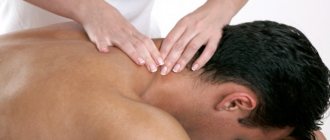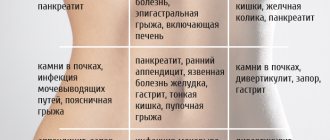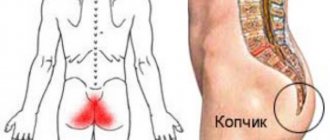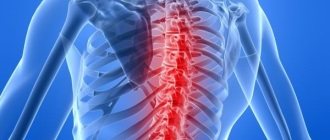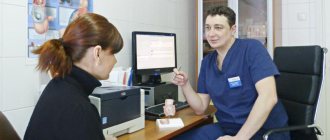External hemorrhoids
- a pathological proctological condition characterized by varicose veins of the external venous hemorrhoidal plexus. It is manifested by a wide range of unpleasant sensations, including a sensation of itching and burning in the anus, aggravated by prolonged standing, sitting, during or after bowel movements.
According to medical statistics, hemorrhoids are one of the most widespread diseases. According to various sources, it affects up to 10% to 80% of the world's population. Proctologists distinguish between external and internal hemorrhoids. The former accounts for 35 to 40 percent of the total number of diagnoses, with male patients suffering from hemorrhoids much more often. It is diagnosed in 80% of cases in men aged thirty to sixty years.
Etiology of external hemorrhoids
The main initiating factor of external hemorrhoids is the disruption of the outflow from the blood veins of the external hemorrhoidal zone due to congenital or acquired anomalies of the venous walls. This leads to its stagnation, enlargement of the cavernous bodies, the development of their pathological changes, and with serious expansion - loss from the muscular basket, displacement to the anus and protrusion under the skin in the corresponding area. Factors that provoke this condition include the following:
- The need to tense the muscles of the perineum, accompanied by an increase in pressure in the hemorrhoids with systematic stool disorders in the form of constipation and prolonged diarrhea, during pregnancy or with birth injuries;
- Lack of sufficient physical activity, lack of exercise, working in a sitting or standing position, lifting heavy weights, consuming food that irritates the intestinal mucosa;
- Compression of the intestines by the uterus increasing as the fetus grows.
Hemorrhoidal thrombosis - symptoms and treatment
Acute hemorrhoids is a disease, with adequate treatment of which, in 98 - 100% of cases, complete relief from the manifestations of thrombophlebitis is possible.* With conservative management of an exacerbation after the signs of inflammation subside, the disappearance of edema, further treatment of hemorrhoidal disease is indicated using numerous methods (minimally invasive: latex ligation, sclerotherapy, laser vaporization or classic hemorrhoidectomy). Correcting changes in chronic hemorrhoidal disease is necessary, among other things, to exclude relapses of thrombophlebitis of the nodes and improve the quality of life.
The choice of method for removing pathologically altered cavernous plexuses in chronic headache depends on their location, size, degree of dystrophic changes in the underlying tissues (stage of the disease), the availability of modern medical equipment in the medical institution and the surgeon’s preferences.
Prevention of the disease consists of eliminating factors that provoke exacerbation of hemorrhoidal disease:
- Normalization of stool;
- Drinking enough fluids throughout the day;
- Increasing physical activity**, combating physical inactivity;
- Nutrition correction - increasing the diet of plant fiber, vegetables and fruits, fermented milk products***;
- Limiting the intake of strong alcohol and spicy foods;
- Treatment of chronic inflammatory processes in the perianal area (proctosigmoiditis, chronic hemorrhoids);
- Reducing body weight to optimal parameters (BMI 20-23);
- Treatment of concomitant diseases - arterial hypertension, diseases of the gastrointestinal tract.
*if in complex therapy surgical aids with coagulation of the vessels feeding the node were used.
**dosed physical activity helps normalize weight, metabolism, and strengthen the pelvic floor muscles. However, they should exclude activities that lead to a sharp increase in intra-abdominal pressure (deadlifts, squats with loads, weightlifting, powerlifting).
***if diet correction is not enough, for persistent constipation, regular use of probiotics and prebiotics, laxatives - lactulose (Lactusan, Duphalac), oval plantain seeds (Mucofalka, Fitomucila) is appropriate. Typically, the side effects of lactulose - bloating, flatulence - are eliminated by reducing carbohydrate intake, which prevents excessive growth of intestinal microflora.
Prevention of acute hemorrhoids in pregnant women
Even at the stage of pregnancy planning, girls need to consult a proctologist, because in the presence of hemorrhoidal disease, stage 1. manifestations may be minimal and unnoticeable to a young woman. However, when carrying a child, all minor problems can become quite painful for the expectant mother, and their effective treatment during pregnancy will be extremely difficult.
Repeated examination of pregnant women is indicated in the 2nd–3rd trimester. Even before the onset of birth, some pregnant women experienced some degree of exacerbation of hypertension, which is associated with impaired venous outflow from the pelvis, an increase in intra-abdominal pressure and changes in blood coagulation parameters. And during natural childbirth, thrombophlebitis occurs in almost half of women in labor due to direct compression of the nodes by the fetal head passing through the birth canal.[13]
For natural delivery, the diagnosis of hemorrhoids is not a contraindication, but the condition requires dynamic monitoring by a specialist and the implementation of certain recommendations.
Symptoms of hemorrhoids
External hemorrhoids of the anus
characterized by pathological changes in the muscular-ligamentous structures of the anus and the final part of the rectum. Due to the weakening of collagen fibers, hemorrhoids protrude even more, the number of arteries and their branches increases, which increases blood flow. Thus, due to the obstructed outflow, it accumulates even more, so the walls of the hemorrhoids stretch even more.
| Symptoms of external hemorrhoids | |
| Symptom | Features of manifestation |
| Pain | External hemorrhoids manifest themselves as painful symptoms, localized in the anus and appearing after prolonged standing or sitting, after physical exertion, as well as during coughing or sneezing. The pain can vary in intensity: from mild to unbearable. |
| Uncomfortable sensations | The external lump of hemorrhoids may manifest itself as severe itching or burning, localized in the anus. |
| Bleeding | They occur quite rarely and are characterized by a minimal volume of lost blood. Extremely rarely, it can appear on feces, mainly on linen or toilet paper. |
| Feeling of a foreign body | If the nodes have a large diameter, the patient can not only feel them on his own, but will also experience unpleasant sensations of a foreign body in the anal area. Inflamed hemorrhoids can cause increased pain and even an increase in overall body temperature. |
Stages of hemorrhoids
Hemorrhoids go through several stages in their development. They are characterized by the following manifestations:
- First. At this stage, moderate bleeding from hemorrhoids in the anus is detected. The patient notices it after defecation on toilet paper. At other times there is practically no bleeding. Sometimes bowel movements are accompanied by shooting pain. In the external form, a small formation appears located at the anus. It's painful. With the internal version of the disease, minor bleeding is observed.
- Second. At this degree, a more pronounced clinical picture appears with a characteristic symptomatic complex. The venous nodes are already protruding, but they are also retracted into the rectum on their own. This process is accompanied by a slight release of blood. Among the typical clinical manifestations, prolapse of hemorrhoids is noted. Blood is released after defecation or at rest. There is mucus discharge from the anus, burning, peeling around the anus and itching. Nodes may fall out. This occurs after significant physical activity, with constipation and sudden movements.
- Third. At this stage, nodes fall out. They can no longer retract on their own. To reduce the formations, a special procedure must be performed. You can perform manual reduction yourself. When the prolapse occurs, bleeding begins. It occurs after intense physical exertion. The patient has bleeding both at rest and after bowel movement. He experiences itching and flaking of the skin near the anus. Often the situation is complicated by the formation of anal fissures, wounds, and sphincter incontinence. The patient experiences constant discomfort, as well as paroxysmal shooting pains. Mucus mixed with blood is often released from the anus. A small amount of it indicates thinning of the walls of the node. A large amount of blood indicates that the blood clot has spread beyond the node.
- Fourth. This stage significantly reduces the quality of life. The nodes fall out and cannot be adjusted either manually or using special procedures for reduction. The patient constantly leaks blood from the nodes. Bleeding increases after defecation. The patient experiences discomfort due to rectal sphincter incontinence. The patient periodically experiences acute pain. Numerous wounds and cracks around the anus are revealed. He constantly scratches this area, and a secondary infection develops. Formed blood clots can break off at any time and block blood flow through the pelvic vessels.
The patient’s treatment tactics depend on the identified stage of hemorrhoids. In the initial stages of the disease, conservative therapy is used. In the later stages of the inflammatory process, surgical techniques are used for treatment.
Complications of external hemorrhoids
If treatment of external hemorrhoids
is not carried out, it can become complicated, manifesting itself as inflammatory processes of cavernous bodies and thrombosis of the blood veins. In the first case, there are three stages of inflammation of hemorrhoids:
- The first is characterized by increased pain, itching and burning, especially after bowel movements or consumption of foods that irritate the intestinal mucosa. An examination by a proctologist reveals a dense, slightly swollen nodule;
- The second is manifested by an increase in the above symptoms, redness of the skin around hemorrhoids, increased swelling and the inability to palpate due to severe pain;
- The third differs in that the inflammation covers the subcutaneous tissue and adjacent tissues. The skin on inflamed hemorrhoids becomes burgundy and has a bluish tint. Under it you can feel the infiltrate, inside of which there is a dense formation. Sometimes necrotic areas are found.
As for thrombosis, it covers one of the nodes and manifests itself with sudden pain symptoms after bowel movement or occurring suddenly. During the examination, the specialist discovers a bluish nodule with swelling.
Hemorrhoids in women
Contrary to popular belief that men are more likely to suffer from hemorrhoids, they often occur in women as well. Predisposition to the disease is inherited, and its occurrence is also determined by the patient’s lifestyle. In patients it often occurs for the following reasons:
- constipation;
- passive lifestyle;
- pregnancy;
- as a complication during childbirth;
- due to vascular pathologies.
Hemorrhoids in women occur due to pathologies in the pelvic cavity, digestive disorders and tumors.
Diagnosis of external hemorrhoids
Diagnosis of hemorrhoids, in fact, is not difficult in any way and can be carried out during an external examination of the patient. The doctor identifies specific lumps localized around the anus. They are palpable only under the skin or bulge outward, forming lumps. Their bluish tint indicates the presence of thrombosis. Further diagnostic studies are aimed at clarifying the primary conclusion and identifying associated pathological conditions. They provide the following:
- Complete blood count - to identify inflammatory processes of hemorrhoids;
- Sigmoidoscopy - to exclude internal hemorrhoids with their prolapse, polyps and neoplasms of malignant etiology;
- Colonoscopy - to obtain more accurate information if rectoscopy did not provide it;
- Angiography - to identify the source of hemorrhage, if any;
- Ultrasound scanning of the rectum - for the best visualization of pathological changes in the cavernous bodies and veins.
External hemorrhoids must be differentiated from prolapsed internal hemorrhoids, prolapse of the rectum, its polyps or neoplasms of any nature.
What are internal and external hemorrhoids
Internal hemorrhoids are located above the pectineal line and are covered with the same cells as those lining the rest of the intestine. External hemorrhoids occur below the line and are covered with skin-like cells.
Outer
Externally it manifests itself as hemorrhoids outside the anus. They are located near the sphincter. The nodes become inflamed and enlarge due to stagnation of blood in the pelvic area. If a blood clot appears in the external node, swelling forms, causing pain to the person. The patient feels a voluminous lump on sensitive thin skin. This development of the disease is typical with an incorrect diet, stagnation of blood in the rectum, low physical activity, and heavy physical exertion. When the skin that covers the node becomes thinner, a blood clot comes out, followed by bleeding.
Interior
With this form, hemorrhoids are almost invisible. They are located inside the anal canal, in the place where it passes into the rectum, under the mucous membrane. The nodes appear due to the protrusion of blood vessels and are usually painless. However, even in this case, hemorrhoidal thrombosis may occur. At an early stage, the disease can be recognized by a small amount of blood discharge after bowel movements.
How to treat external hemorrhoids?
The treatment tactics are chosen by the attending physician, guided by the patient’s individual indications and the results of diagnostic studies. Unfortunately, conservative therapy cannot provide a complete cure, but it can eliminate all the unpleasant symptoms of hemorrhoids: swelling, pain, discomfort. Patients should eat in accordance with the diet selected by the doctor, move more and avoid lifting heavy objects.
The best results for external hemorrhoids are obtained by removing the nodes: thanks to it, you can eliminate this unpleasant problem for a very long time and even forever. The operation is performed under local anesthesia and does not require the patient to remain in the hospital. Various techniques are used in the process:
| Methodology | Description |
| Hemorrhoidectomy | Radical excision, indicated in advanced stages of hemorrhoids with large nodes. Aimed at their removal by stitching the leg. Requires general anesthesia and is characterized by a minimal risk of complications. |
| Latex ligation | A minimally invasive procedure that involves placing a latex ligature on the hemorrhoid stem in order to compress the blood vessels feeding the node and stimulate its death. |
| Photocoagulation | The process uses a focused infrared beam, with which the doctor cauterizes the hemorrhoidal node, which provokes disruption of its blood supply and subsequent atrophy. |
If a patient has thrombosis, he is prescribed thrombolytics (at an early stage) or anticoagulants. If drug therapy does not give the desired result, the blood clot is removed through surgery. It involves making an incision on the node and removing the clot.
What else is important to know about hemorrhoids?
75% of people with hemorrhoids experience signs of constipation4. These may be symptoms such as hard, painful stools, excessive and ineffective straining when going to the toilet, which, in turn, can provoke or aggravate hemorrhoids (you can read more about constipation and its symptoms in the article “What is constipation?”).
- That is why people who are faced with the problem of hemorrhoids and who simultaneously experience signs of constipation need to improve the functioning of their intestines as a whole.
- However, even if a person does not suffer from constipation due to hemorrhoids, the use of laxatives may be justified in order to soften the stool and reduce pain when going to the toilet.
Prognosis of external hemorrhoids
With timely diagnosis and treatment of external hemorrhoids, the prognosis is favorable. The disease will proceed latently, without creating discomfort or reducing the patient’s quality of life. Vein thrombosis is a serious problem: treatment in this case must be started immediately, otherwise complications cannot be avoided.
The Doctor Nearby network of clinics invites you to undergo diagnostics and treatment for hemorrhoids in Moscow. Our clinics are equipped with the latest technology and have a powerful diagnostic base that allows us to accurately diagnose and develop treatment tactics. We employ highly qualified proctologists with many years of practical experience. They know how to cure hemorrhoids and return the taste of life to the patient.
You can make an appointment with our specialists by filling out and sending us the online form presented on the website, or by contacting our operators!
Hemorrhoids in men
Hemorrhoids occur slightly more often in men than in women. The reason for this is the lack of attention on the part of the stronger sex to their health. They see a doctor in the later stages of the disease. The causes of hemorrhoids in men are as follows:
- work with a predominance of heavy physical labor, heavy lifting;
- sedentary work;
- presence of bad habits: alcohol abuse, smoking;
- nutritional obesity;
- neglecting the need to regularly empty the intestines;
- prolongation of the act of defecation;
- chronic stress.
The causes of secondary hemorrhoids are somatic diseases: oncological processes, portal hypertension, heart failure.
Prevention of hemorrhoids
Prevention is the most effective treatment. Diet and adequate fluid intake are very important to maintain normal bowel movements. Symptoms of hemorrhoids can occur with the passage of hard stools and constipation, as well as with diarrhea and frequent bowel movements. People with constipation may need a high-fiber diet, adequate fluids, and stool softeners. Those who have excessively frequent bowel movements may need antidiarrheal medications and dietary adjustments. These preventive measures reduce the strain required to have a bowel movement, thereby reducing the pressure in the blood vessels to prevent swelling.
The SM-Clinic Surgery Center provides services for prompt diagnosis and effective treatment of hemorrhoids using non-surgical methods and surgical techniques. Our patients recover within 24 hours in a comfortable hospital setting and quickly return to their normal lifestyle. Other treatment methods are also used, depending on the stage and type of disease. Advanced equipment is used for diagnostics, ensuring accuracy and speed of obtaining results.
Why are hemorrhoids dangerous?
The most common complications of hemorrhoids are inflammation, thrombosis or bleeding. It is important to remember that rectal bleeding or blood in the stool is always abnormal, and although it can be caused by a relatively benign cause (such as hemorrhoids), other, more serious causes can be life-threatening. These include bleeding from ulcers, diverticulitis, inflammatory bowel disease and tumors. This is especially important if a person is taking blood thinners.
How to get rid of hemorrhoids at different stages
Hemorrhoids will recur after conservative treatment in approximately 50% of cases, while the recurrence rate after surgery is only 5%. The goal is to control hemorrhoid inflammation through diet and hydration so that surgery is not required. In this regard, hemorrhoids are a lifelong condition that needs to be managed.
Hemorrhoids of 2 and 3 degrees are initially treated conservatively or using minimally invasive methods. These include injections into the hemorrhoidal vein to sclerosize or harden it, using rubber bands to cut off the blood supply and cause the hemorrhoidal tissue to shrink, or other procedures that cause the lining to shrink and die.


